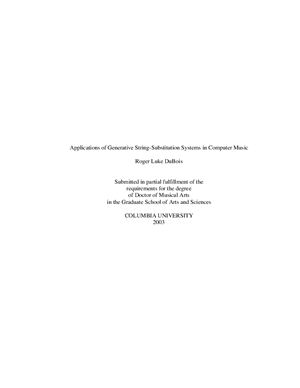Submitted in partial fulfillment of the
requirements for the degree
of Doctor of Musical Arts
in the Graduate School of Arts and Sciences
COLUMBIA UNIVERSITY
2003
164 pages
ABSTRACT
Applications of Generative String-Substitution Systems in Computer Music
Roger Luke DuBois
The purpose of this dissertation is to create and explore potential taxonomies for
using algorithmic string-substitution systems in the generation of music. The focus of the
author’s research is on using a specific category of string rewriting systems (called
Lindenmayer, or L-systems) to generate musical material based on a musical primer
provided by a live musician or musicians. The author explores and describes a variety of
possible composing methodologies whereby a computer can generate, in real time,
appropriate accompanying music and signal processing to a live performer. By
experimenting with different taxonomies of mapping source material (live musical input)
to accompanying processes (provided by the computer), an extensive system for
generating a varied, yet systematically cohesive, corpus of musical work can be achieved.
A series of short compositions based on this string-substitution process are included as
applications of this system.
Applications of Generative String-Substitution Systems in Computer Music
1. Introduction
2. Lindenmayer Systems
Overview of L-systems
Turtle graphics and branching
Lindenmayer Systems and music: prior art
3. Mapping and Rewriting Schemes
Event-literal symbolic mapping
Spatial symbolic mapping
Static-length L-systems
Parametric symbolic mapping (metadata)
4. Interactive Performance Using L-systems
Overview of Scheherazade
Symbolic encoding of musical information
L-systems as transfer functions
L-systems as symbolic filters
Figurative encoding
Branching as polyphonic accompaniment
Parametric parsing
5. Conclusion
Appendix: source code examples
Scores
requirements for the degree
of Doctor of Musical Arts
in the Graduate School of Arts and Sciences
COLUMBIA UNIVERSITY
2003
164 pages
ABSTRACT
Applications of Generative String-Substitution Systems in Computer Music
Roger Luke DuBois
The purpose of this dissertation is to create and explore potential taxonomies for
using algorithmic string-substitution systems in the generation of music. The focus of the
author’s research is on using a specific category of string rewriting systems (called
Lindenmayer, or L-systems) to generate musical material based on a musical primer
provided by a live musician or musicians. The author explores and describes a variety of
possible composing methodologies whereby a computer can generate, in real time,
appropriate accompanying music and signal processing to a live performer. By
experimenting with different taxonomies of mapping source material (live musical input)
to accompanying processes (provided by the computer), an extensive system for
generating a varied, yet systematically cohesive, corpus of musical work can be achieved.
A series of short compositions based on this string-substitution process are included as
applications of this system.
Applications of Generative String-Substitution Systems in Computer Music
1. Introduction
2. Lindenmayer Systems
Overview of L-systems
Turtle graphics and branching
Lindenmayer Systems and music: prior art
3. Mapping and Rewriting Schemes
Event-literal symbolic mapping
Spatial symbolic mapping
Static-length L-systems
Parametric symbolic mapping (metadata)
4. Interactive Performance Using L-systems
Overview of Scheherazade
Symbolic encoding of musical information
L-systems as transfer functions
L-systems as symbolic filters
Figurative encoding
Branching as polyphonic accompaniment
Parametric parsing
5. Conclusion
Appendix: source code examples
Scores

